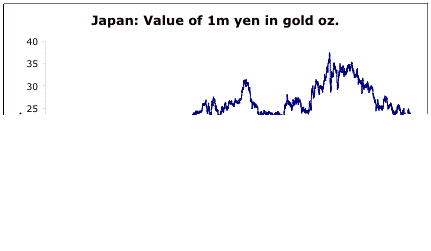Inflation or Deflation?
April 2, 2006
There has been something of a “debate” going on among the more bearish investors as to whether the future is more likely to be inflationary or deflationary.
The answer right now seems quite clear: inflationary. The chance of things turning around and becoming deflationary, as Japan was during the 1990s, are extremely remote. We would have to see the dollar worth 1/180th or so an ounce of gold for that to happen.
Inflationary effects are monetary distortions caused by a decline in currency value. The easiest way to see this decline in currency value is to measure it against gold. If the dollar was worth 1/300th oz. of gold and is now worth about 1/600th oz. of gold, obviously the dollar’s value has fallen, against gold. Since gold is the best measure of value we have, we can say with a fair degree of confidence that the dollar’s value has declined in absolute terms, which would produce inflationary effects.
I have been describing the monetary distortions caused by a decline in currency value using terminology like “if the dollar goes to $0.50, then it will eventually tend to require two dollars to buy what one dollar used to buy.” Of course this is nonsensical at the surface, as it compares the dollar to itself, but it suggests the kind of decline in absolute terms which causes inflationary effects. In our example above, it is quite easy to see that the value of $300 has gone from one ounce of gold to 1/2 oz.
Likewise, deflationary effects are monetary distortions caused by a rise in currency value. If the dollar goes to $2, then it will eventually tend to take $0.50 to buy what $1 used to buy. We can measure this most effectively by witnessing the value of dollars in gold terms. If a natural comfort zone for the dollar is now around $350/oz. or perhaps $380/oz., then we would have to see something like $180/oz. (i.e. a dollar worth 1/180th oz. of gold, or the value of $350 rising to 2 oz. of gold) for the “dollar to rise to $2” and produce deflationary effects.
Monetary deflation, as happened in Japan during the 1990s, looks like this:

Do you see how the yen’s value rose in gold terms? We can see that the “yen went to Y2,” causing the monetary distortion known as deflation. We can also see how, since late 2001, the yen’s value has fallen back toward where it used to be in the 1980s, creating the condition often known as “reflation.”
Suffice to say, that is not the situation today in the U.S., or indeed around the world. I see considerable risk that the value of currencies worldwide will fall quite a bit further, which is to say, greater and greater inflation.
However, at the same time, it is quite likely that asset values will decline, there will be a certain amount of economic slowdown and recession, and that the pace of debt expansion will slow. This seems to be what people have been calling “deflation.” However, these are all symptoms of inflation. Look at the 1970s, for example. Did asset values decline? Certainly, in real terms (i.e., compared to the universal currency of gold), although the inflationary effect boosted the nominal prices of hard assets including real estate. Indeed, it was this decline in asset values during the 1970s that led to the rise in asset values during the 1980s and 1990s. The 1970s were also known for bitter recessions, mostly caused by higher interest rates (another symptom of inflation). Higher interest rates, in turn, also tend to lead to a reduction in debt creation activity. Look at any country that has experienced a high degree of inflation, and you will generally find low asset prices, a moribund economy, ridiculous interest rates and very limited debt activity.
In an environment of hyperinflation, it may take a trillion dollars to buy an ounce of gold, and a cup of coffee may cost two billion dollars. In this extreme example, we can see that if the price of a nice house in Los Angeles was then ten trillion dollars, or ten ounces of gold, or 5000 cups of coffee, the house’s selling price is very cheap by our standards today but it has a very high nominal price! This may seem silly, but I note that, since 1940, such an environment of hyperinflation has been experienced in the following countries:
France
Germany
Japan
Italy
Russia and the former Soviet Union, and the Soviet satellite states in the Baltics, Poland, etc.
China and Taiwan
All of Latin America
Virtually all of Africa
Much of ex-Japan Asia
Countries which have experienced hyperinflation just since 1980 include:
All of Latin America
Much of Africa
Indonesia
Turkey
All of the former Soviet Union and satellite states
Former Yugoslavia
The U.S.’s last bout of hyperinflation was in the 1780s. Can’t happen here? It has happened here, although quite a while ago.
We are still quite early in the inflation game, in the U.S. and worldwide, so it is rather premature to talk about hyperinflation. However, things do get out of hand from time to time, so it is worth keeping in mind.

